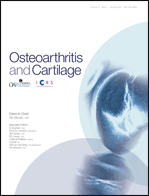
OSTEOARTHRITIS
The effect of weight loss and exercise training on BMD in obese adults with OA
This report has been verified
by one or more authors of the
original publication.
Osteoarthritis Cartilage. 2014 Jun;22(6):726-33
284 older (>55 years of age), overweight/obese adults with grade II-III radiographic tibiofemoral osteoarthritis (OA) or tibiofemoral plus patellofemoral OA, were randomly assigned to 1 of 3 groups to determine the effect dietary-induced weight loss or weight loss plus exercise had on bone mineral density (BMD). Patients took part in a dietary intervention, an exercise intervention, or a combination of the two. Results from the study demonstrated that patients in all three groups lost a significant amount of weight when compared to baseline measurements. Significant treatment effects were observed for BMD of the hip and femoral neck regions, with the diet group and diet plus exercise group demonstrating similar relative losses. Results of the study also indicated that BMD correlated positively with changes in body weight.
Unlock the full ACE Report
You have access to {0} free articles per month.Click below to unlock and view this {1}
Unlock NowCritical appraisals of the latest, high-impact randomized controlled trials and systematic reviews in orthopaedics
Access to OrthoEvidence podcast content, including collaborations with the Journal of Bone and Joint Surgery, interviews with internationally recognized surgeons, and roundtable discussions on orthopaedic news and topics
Subscription to The Pulse, a twice-weekly evidence-based newsletter designed to help you make better clinical decisions
Exclusive access to original content articles, including in-house systematic reviews, and articles on health research methods and hot orthopaedic topics
Or upgrade today and gain access to all OrthoEvidence content for just $1.99 per week.
Already have an account? Log in


Subscribe to "The Pulse"
Evidence-Based Orthopaedics direct to your inbox.
{0} of {1} free articles
Become an OrthoEvidence Premium Member. Expand your perspective with high-quality evidence.
Upgrade Now













































































